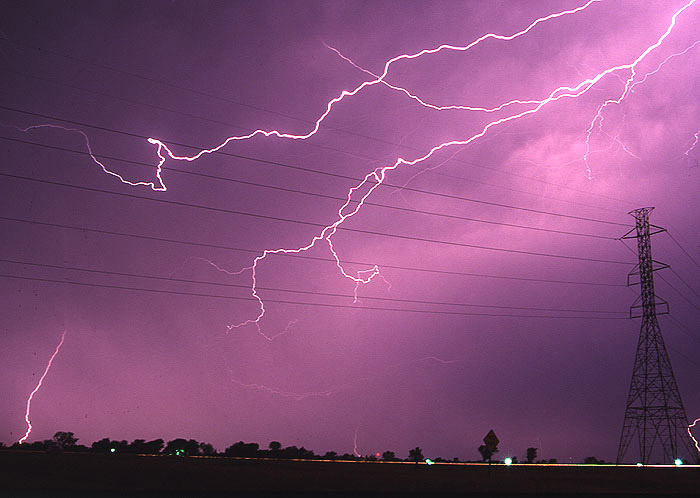
Expert Systems 9501 Tinker Court Burke , VA 22015
|
Expert Systems 9501 Tinker Court Burke , VA 22015
|
PCS CELL SITE DAMAGE FROM LIGHTNING Lightning strike damage to PCS cell sites and associated equipment, radio and microwave towers, TV antenna sites, and other antenna structures results in losses in the hundreds of millions of dollars annually in North America. A recent July thunder storm in the Northwest temporarily terminated 38 PCS working cell sites. The real disappointment here is that most of this damage and resulting down time could have been all but totally eliminated. Insurance costs on these towers and associated equipment will become astronomical due to the constantly reoccurring damage. It's difficult to understand why PCS providers continue to accept rising insurance costs and poor service reliability, when cost-effective protection is readily available. Why are these tower locations so susceptible to lightning-induced damage? There are two reasons: (1) antenna sites are not grounded to properly conduct light strike energy, because no code demands it, and (2) the wire-line communication service providers rarely install isolation equipment to protect communications services from a lightning induced Ground Potential Rise (GPR), because no code demands it. Why aren’t antenna sites properly grounded to protect against lightning strike energy? Because the National Electrical Code (NEC) is the controlling code for grounding and it does not address lightning strike energy, only electrical supply energy! Section 810-2 of the NEC, Grounding Conductors, describes how to ground an antenna with a single ground rod and a #6 gauge wire to insure the safety of personnel in case the antenna should become electrically energized from contact with the electric power system. This method of grounding is completely inadequate to dispose of an average 20,000 Ampere lightning strike. This method of grounding for lightning strike energy is as effective as trying to use a one inch diameter pipe, five miles long to supply water to all of New York City! Why aren’t wire-line communication service providers isolating their communication equipment from lightning induced GPR? Because IEEE Std. 487-1992 is the controlling standard for isolation against a GPR and it applies only to electric power fault energy. At sites other than electric power locations the requirement for isolation of wire-line communications is not addressed! IEEE Std. 487 describes how to isolate wire-line communication services from 300-Volt to 30,000-Volt GPR due to a faulting power line. However, Standard 487 does not address a lightning induced GPR at a non-power site, which is ten-thousand-times more likely to occur than a power-line-fault GPR. Thus, with respect to lightning strike GPR, we have two controlling codes that fail to adequately address proper antenna grounding and isolation of communication services. These code failures mean real trouble for the PCS provider! Why? Because low bid wins the contract and no one is going to bid more than the minimum requirements specified in the codes! Ironically, the two solutions to properly protect against lightning induced GPR at antenna sites; i.e., current division grounding and isolation of communications lines, can be met with relatively little extra cost. In fact, these additional costs are minuscule when compared to the total site construction cost and the costs of ongoing GPR damage repair. Instead of providing a single ground rod and a #6 gauge wire from one of the tower legs, it is far superior to install a star grounding system (ten or more legs 40 to 80 feet) off of a ground ring that will divide the current from a lightning strike into smaller segments. This grounding scenario will not only provide a lower-impedance ground, but will also lead lightning-induced current away from the antenna building, thereby reducing the resulting GPR of the building’s grounding system. The approximate cost for grounding the antenna in this manner is $4,000. Instead of providing gas tubes on the wire-line communications services entering the antenna building, install isolation equipment on all entering pairs. This will isolate all wire-line services from remote ground in the event of a lightning induced GPR and thus protect all associated equipment from damage. The use of gas tubes does not protect the communications equipment from on-site GPR and in reality allows GPR current to flow in a reverse direction from the site, which damages equipment and cable alike. The cost for isolating the communication pairs is only about $700 per 4-Wire T-Carrier circuit or 2-Wire voice pair. Thus, for less than 1% of the site construction budget you can effectively eliminate all future communication equipment damage from lightning strike energy. The average damage resulting from the first lightning strike on an improperly protected antenna site is approximately $25,000 or five times the cost of properly protecting the site! In Cell Site construction bid specifications, future site owners should require a high-quality grounding system such as a star configuration grounding system and require isolation protection for all wire-line communications service. If they don't, they're asking for serious unnecessary trouble and expense down the line. *See related article Getting Grounded
New! Lightning Protection Checklist for Risk Management New ! Lightning Protection Guide for protecting equipment and personnel New ! Lightning Storm Dot Com view the current lightning map of the United States New ! Lightning and GPR Related Links New ! Lightning Related Articles New ! Lightning Related Reference Books New ! Wire-Line Communications Isolation or Fiber Optic Facility Extensions ? Solving High Voltage Problems In Wireless/Utility Collocations Eliminating Lightning Damage at PCS Cell Sites Isolation of Wire-line Communications in an Unregulated Power Market PCS Locations in High-Voltage Corridors Be alert to the Danger of GPR On the Road With Ernie Great Balls of Fire! Destructive Surges Wireline Isolation Theory and Application When to Protect Cell Sites from GPR GPR Related Software Links to US Energy Utilities Communications Related Links Return to GPR Expert Home
|